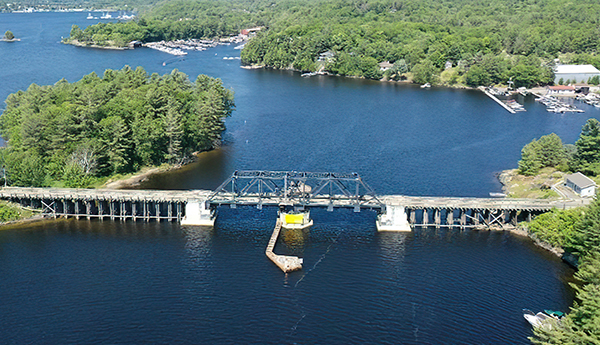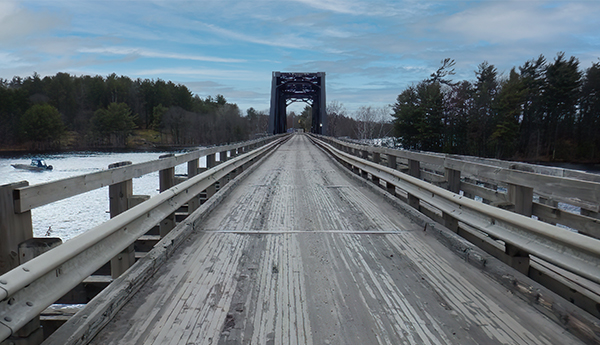Wasauksing Swing Bridge: Preserving history and connections
Built in 1912, the historic Wasauksing Swing Bridge is an essential link between communities living in Northern Ontario. The bridge, spanning a narrow navigation channel between Rose Point and Parry Island, is the Wasauksing First Nation's only road access from the island to the mainland.
Originally constructed as a railway crossing, the bridge was modified over time so both trains and cars could use it. Rail service was terminated in 1989. Today, the bridge remains a single-lane structure made mainly of timber with a steel truss swing bridge at mid-span.
While the bridge is owned and maintained by the Government of Canada, it's operated by the Wasauksing First Nation. Public Services and Procurement Canada (PSPC) awarded the construction and maintenance contracts to the First Nation, which recently implemented several important rehabilitation projects on the structure.

Rehabilitation and heritage conservation
Over the past few years, projects have targeted improvements to the road deck, including the replacement of the wooden road surface. The pier support structure and fenders, to protect the bridge from passing ships, have also been rehabilitated.
Work on historic structures brings a unique set of challenges, including the need to maintain their look and feel. "During repairs and rehabilitation, every effort is made to maintain the original design and use the same construction materials," explains Mehdi Shabestary, Project Manager at PSPC.
"The age and therefore the heritage characteristics of this bridge and the vital function it performs had to be preserved. Preserving part of Canada's history in this timber bridge is interesting in and of itself. Of course, from an engineering point of view, it's always impressive to see the magnitude of what engineers and workers were able to accomplish a hundred years ago, without the modern technology we have today."


For Shabestary, a project like this involves many considerations beyond the completion of the physical work. "The high level of respect we give to the environment and wildlife in the area where the work is being carried out is a priority."
In addition to the environmental challenges, all the repairs had to be carried out while avoiding or minimizing closures that would have had an impact on land and marine traffic, including emergency services. The project schedule also had to take into account the limited construction season, due to the winter climate, and prevent any interference with the important agricultural activities in the region.
Collaboration meets reconciliation
The bridge operation schedules are managed by Indigenous Services Canada, and the Wasauksing First Nation operates the bridge on site. PSPC's engineering services are required to conduct periodic safety and condition inspections, advise on required upkeep and maintenance needs, and manage related work to ensure safe and uninterrupted bridge operations for both land and marine traffic.
With experience gained from previous maintenance work on the structure, the Wasauksing First Nation was well positioned to carry out the recent rehabilitation projects. The key to the success of the projects for each of these contracts was consistent and timely communication and consultation between the federal departments and the community. From project inception to completion, open, inclusive and transparent communication was maintained between all the stakeholders.
"This collaboration between our 3 organizations is deeply rooted in client service excellence, mutual respect, open and transparent communication, and an understanding of the vital roles each party plays," says Shabestary.

The success and collaboration between all parties is sure to continue. A new rehabilitation contract started in June 2023 that focuses on the structural rehabilitation of the eastern approach sections of the bridge. Plus, in March 2024, the maintenance contract with the Wasauksing First Nation will be renewed for another 2 years with an option to extend for an additional 3 years.
For more stories about PSPC people, projects and initiatives, don't forget to add Our stories to your favourites.